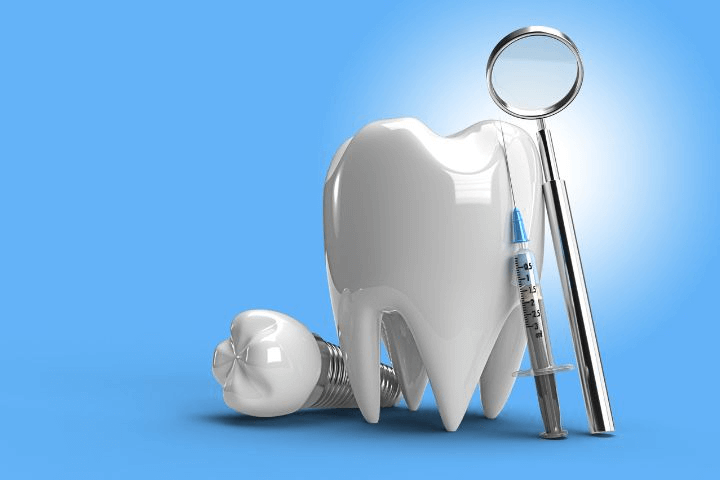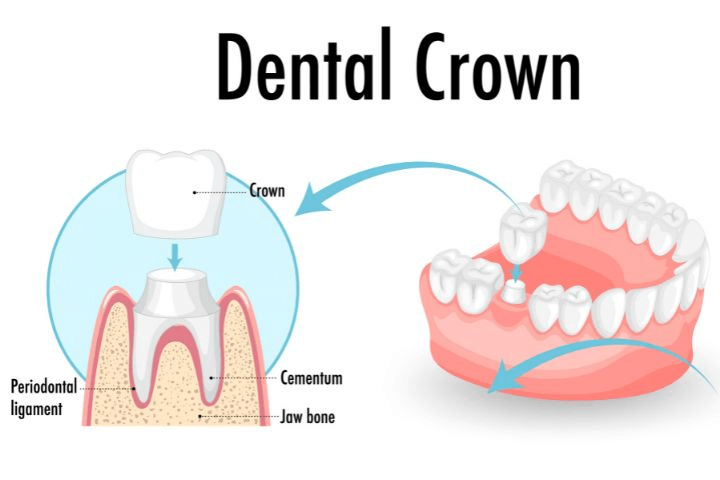When it comes to preserving the health and longevity of a root canal-treated tooth, the role of a dental crown is crucial. In this article, we delve into the fascinating world of root canal treatment and explore the lifespan of a root canal without its crown. We’ll address common concerns and misconceptions, providing you with valuable insights.
Root Canal Treatment Root canal treatment is a dental procedure designed to save and restore a severely damaged or infected tooth. By removing the infected pulp and disinfecting the root canal system, this treatment alleviates pain and prevents further complications. It’s a highly effective way to retain a natural tooth and avoid extraction.
The Function and Importance of a Dental Crown
A dental crown serves a vital function and holds immense importance in dental care. Let’s explore the function and significance of a dental crown in detail:
-
Definition and Purpose
- A dental crown is a custom-made cap that is placed over a damaged or weakened tooth.
- It completely covers the visible portion of the tooth, extending to the gum line, providing a protective and aesthetic restoration.
-
Strength and Stability
- One of the primary functions of a dental crown is to strengthen and stabilize a compromised tooth.
- It reinforces the tooth’s structure, preventing further damage and potential fractures.
-
Protection
- Dental crowns act as a shield, protecting the underlying tooth from decay, erosion, and external forces.
- They provide a barrier against harmful bacteria and reduce the risk of infection.
-
Preservation of Natural Toot
- Instead of opting for an extraction, a dental crown allows for the preservation of the natural tooth.
- By restoring the tooth’s functionality, it enables normal chewing, biting, and speaking.
-
Restoration of Aesthetics
- Dental crowns are designed to closely resemble natural teeth in color, shape, and size.
- They contribute to a visually pleasing smile, enhancing the overall appearance.
-
Longevity and Durability
- A well-crafted dental crown can last for many years with proper care and maintenance.
- It withstands the forces of regular biting and chewing, providing long-lasting results.
-
Support for Dental Restorations
- Dental crowns play a crucial role in supporting various dental restorations, such as dental bridges or dental implants.
- They act as an anchor, ensuring stability and functionality to the overall dental prosthesis.
-
Enhanced Oral Health
- By covering and protecting a damaged tooth, dental crowns contribute to improved oral health.
- They prevent further decay or damage, allowing for easier cleaning and maintenance of the tooth.
How Long Can a Root Canal Survive Without a Crown?
The longevity of a root canal without a crown is a common concern among individuals who have undergone this dental procedure. Let’s delve into the topic and explore how long a root canal can survive without a crown:
-
The Role of a Dental Crown
- A dental crown is typically recommended after a root canal treatment to provide protection and support to the treated tooth.
- It covers the entire tooth structure above the gum line, safeguarding it from potential damage and reinfection.
-
Immediate Post-Root Canal Period
- Immediately after a root canal, the tooth may be temporarily restored with a filling material.
- This temporary restoration provides some level of protection but is not intended for long-term use.
-
Timeframe for Crown Placement
- The ideal timeframe for placing a permanent dental crown after a root canal varies based on individual cases.
- Generally, it is recommended to have a crown placed within a few weeks to a month after the root canal procedure.
-
Impact of Delayed Crown Placement
- Delaying the placement of a dental crown after a root canal can compromise the long-term success of the treatment.
- Without a crown, the treated tooth is more susceptible to fractures, reinfection, and further damage.
-
Risks of Prolonged Delay or Absence of Crown
- Over time, a root canal-treated tooth without a crown becomes vulnerable to bacterial intrusion, decay, and structural breakdown.
- The absence of a crown increases the risk of complications, such as fractures, which may require additional dental interventions.
-
Temporary Measures to Protect the Tooth
- If there is a delay in getting a permanent crown, your dentist may recommend interim measures to protect the treated tooth.
- These can include the use of a temporary crown or a protective dental restoration.
-
Individual Factors and Tooth Condition
- The survival of a root canal-treated tooth without a crown can vary depending on factors such as the tooth’s location, condition, and overall oral hygiene.
- While some individuals may experience a longer period without a crown without immediate issues, it is not a recommended practice.
-
Consultation with a Dental Professional
- To determine the specific timeframe and risks associated with delaying crown placement after a root canal, it is essential to consult with a dental professional.
- They will evaluate your unique situation and provide personalized guidance based on your oral health needs.
Signs and Symptoms of Compromised Root Canal Treatment
Recognizing the signs and symptoms of compromised root canal treatment is vital for maintaining good oral health and addressing any potential issues promptly.
Here are some indicators that may suggest a compromised root canal treatment:
-
Persistent or Recurrent Pain
- Experiencing persistent pain or recurring discomfort in the tooth that has undergone a root canal treatment can indicate a problem.
- This pain may be sharp, throbbing, or radiating, and it might occur spontaneously or worsen with chewing or applying pressure to the tooth.
-
Sensitivity to Heat or Cold
- Sensitivity to hot or cold temperatures that lingers for an extended period can be a sign of a compromised root canal treatment.
- The tooth may feel sensitive or painful when consuming hot or cold foods and beverages, even after the initial sensitivity associated with the root canal has subsided.
-
Swelling or Gum Tenderness
- Swelling or tenderness in the gum tissue surrounding the root canal-treated tooth could indicate an infection or inflammation.
- The gums may appear red, swollen, or feel sensitive to touch, indicating a potential issue with the root canal treatment.
-
Abscess Formation
- The development of a pimple-like bump or a small, raised area on the gum near the root canal-treated tooth may signify the presence of an abscess.
- An abscess is a localized infection that can develop when bacteria accumulate in the root canal system or surrounding tissues.
-
Changes in Tooth Appearance
- Discoloration or darkening of the tooth can be a sign of internal damage or compromised root canal treatment.
- If the tooth treated with a root canal begins to appear noticeably different in color compared to the surrounding teeth, it may require attention.
-
Mobility or Shifting of The Tooth
- An untreated or poorly treated root canal can lead to the weakening of the tooth structure.
- As a result, the affected tooth may become loose, shift out of position, or feel unstable when biting or chewing.
-
Recurrence of Infection
- If you have previously undergone a root canal treatment and experience a reoccurrence of symptoms such as pain, swelling, or sensitivity, it could indicate a failed or incomplete root canal treatment.
- In such cases, the infection may persist or return, requiring further evaluation and potential retreatment.
The Crown Placement Process
The crown placement process is a crucial step in restoring a tooth that has undergone a root canal treatment or requires protection and reinforcement.
-
Assessment and Treatment Planning
- Before the crown placement, your dentist will conduct a thorough examination of the tooth and surrounding tissues.
- They will evaluate the root canal treatment’s success, tooth structure, and any additional considerations for crown placement.
- X-rays or other imaging techniques may be used to assess the tooth’s condition and determine the appropriate crown size and shape.
-
Tooth Preparation
- To ensure a proper fit, the tooth receiving the crown will be prepared by removing a small amount of the outer enamel.
- This step allows room for the crown to be placed securely without compromising the neighboring teeth.
- Your dentist will use specialized dental instruments to reshape the tooth and create a suitable foundation for the crown.
-
Impression Taking
- After the tooth preparation, an impression of the prepared tooth and the surrounding teeth is taken.
- The impression captures the unique shape and alignment of your teeth, providing a model for the dental laboratory to create a custom crown.
- The dentist will use a putty-like material or a digital scanner to take the impression, ensuring precise measurements for an accurate fit.
-
Temporary Crown Placement
- While the permanent crown is being fabricated at the dental laboratory, a temporary crown is typically placed over the prepared tooth.
- The temporary crown provides protection and aesthetic appearance during the waiting period.
- Although temporary crowns are not as durable as the final crown, they help maintain tooth function and prevent sensitivity.
-
Crown Fabrication
- The dental laboratory will use the impression and specifications provided by your dentist to fabricate the permanent crown.
- Skilled dental technicians will craft the crown from materials such as porcelain, ceramic, or metal alloy, ensuring a natural look and optimal strength.
- The fabrication process usually takes a couple of weeks, during which the temporary crown remains in place.
-
Final Crown Placement
- Once the permanent crown is ready, you will return to your dentist for the final crown placement appointment.
- The temporary crown is removed, and the dentist will carefully check the fit, color, and aesthetics of the permanent crown.
- With the use of dental cement or adhesive, the crown is bonded securely onto the prepared tooth.
- Your dentist will make any necessary adjustments to ensure proper occlusion and bite alignment.
-
Bite Evaluation and Polishing
- After the crown placement, your dentist will evaluate your bite to ensure proper distribution of forces when you chew.
- Any irregularities or interferences in the bite may be adjusted for optimal comfort and function.
- The crown and adjacent teeth are polished to provide a smooth surface and natural appearance.
-
Oral Care Instructions
- Your dentist will provide specific instructions on how to care for your newly placed crown.
- This may include recommendations for oral hygiene practices, such as brushing and flossing techniques, to maintain the crown’s longevity.
- Regular dental check-ups and professional cleanings are essential to monitoring the crown’s condition and overall oral health.
Maintaining and Caring for a Dental Crown
Proper oral hygiene practices, including regular brushing, flossing, and rinsing, are essential for maintaining the health of a dental crown.
Additionally, certain dietary considerations, such as avoiding hard or sticky foods, can help protect the crown and prevent damage.
Regular dental check-ups and professional cleanings are also vital to monitor the crown’s condition and address any potential issues.
Conclusion
In conclusion, a dental crown is a vital component of a successful root canal treatment. Its function in preserving the integrity, strength, and aesthetics of a root canal-treated tooth cannot be overstated.
Timely crown placement is crucial to ensure the long-term survival and durability of the root canal. By empowering readers with this knowledge, we encourage them to make informed decisions and prioritize their oral health. Remember, a healthy smile starts with a well-protected root canal!




